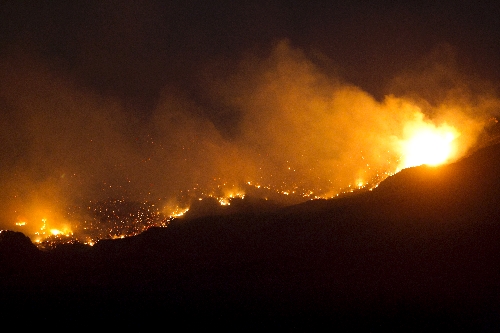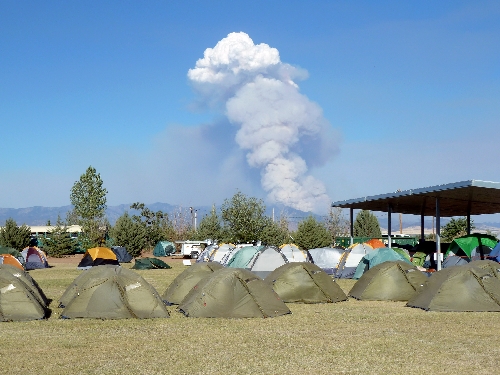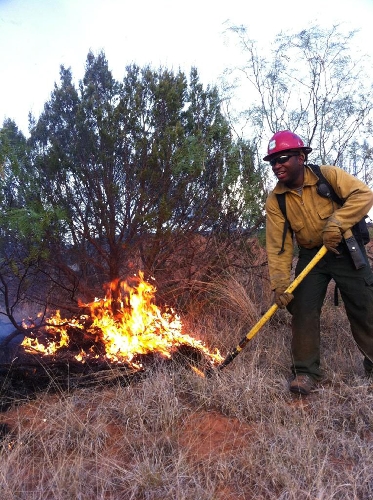History’s heroes: Las Vegas locals return from fighting Arizona fires



Although he calls his recent firefighting stint in Arizona “no different than the rest,” southwest resident Brian Kitchen’s modesty hides a historic story.
Kitchen, 32, and several other local firefighters recently returned from the cluster of fires in Arizona that broke state records and made national headlines.
“It’s one of the largest,” said Kitchen of Arizona’s Horseshoe 2 fire, trying to recall other assignments he has had in his 12 years with the U.S. Forest Service. Other notable blazes he has helped fight include the Rodeo-Chediski fire in 2002, once that state’s largest, and San Diego’s 2003 Cedar fire.
“After a while, they start to run together, ” he added.
The Horseshoe 2 fire covered more than 200,000 acres in southeastern Arizona, destroying 23 structures, according to the incident report. The blaze, which is now contained, was one of a cluster of fires in the state last month. Fa rther north, the Wallow fire covered more than 500,000 acres and destroyed 32 residences and about 40 other buildings as it also crept into western New Mexico. It is now Arizona’s largest wildfire after surpassing the 2002 Rodeo-Chediski blaze.
Kitchen was one of about 40 firefighters from various agencies in Nevada called to the fires in two-week shifts. Hundreds of people from across the region also worked the blazes, which spanned from late May to early this month.
“On these fires, they really almost bring in a small city,” said Ray Johnson, a Centennial Hills resident of the U.S. Forest Service. “Thousands of people come to help sometimes.”
Johnson, 50, manned the security detail at the west base camp for Horseshoe 2. The camp, stationed at a local elementary school, sat about a half-hour south of Wilcox, Ariz., and a half-hour north of the Mexican border. It housed at least 40 fire trucks, bull dozers and nearly 1,000 crew members. People from the Monument fire also filtered through the camp, he said.
Johnson worked nights for two weeks straight, patrolling the area to ensure that the crews and millions of dollars in equipment stayed safe, he said. With so many people in such tight quarters, he said he could walk the entire grounds in little more than five minutes, making it easy to patrol. The security team also worked with border patrol, but no problems of anyone trying to illegally cross into the camp were reported.
“You want to be involved. You want to participate. But you have to take a step back and realize you’re still contributing,” said Johnson, who usually works on the fire line. “On the security detail, you’re just trying to keep the area safe for all the people there doing these important jobs.”
With those duties comes little sleep. Crews on a large wildfire work 16-hour days and sleep where they can. At the Horseshoe 2 camp, that meant pitching tents on the football field or sleeping on the hard gymnasium floor.
To save the three -hour round trip driving time to the headquarters, Kitchen spent his first six nights near the fire. The only downside, he said: The food is cold by the time it’s delivered in a bucket from the base.
“It took me awhile to adjust,” Kitchen said, laughing. “Before I did this job, I never went camping. It is a big change.”
Dennis Darling, a Summerlin resident who led a task force and trained Kitchen for his supervisor certification, said camping by the fire is better because it’s quieter. Darling, 42, said he gives up anything for more sleep while on the job.
“You cut out things you just don’t need to do. Showers just don’t happen,” said Darling, who didn’t bathe for 16 days while working Horseshoe 2. “You usually have to wait in line for an hour for the shower. That’s an hour for sleep I’d rather take.”
The local firefighters said a typical work day on the line means creating fuel breaks with bull dozers and shovels and controlled burns until 11 p.m. — and then checking that the area is still secure by 6 the next morning — all in gear that weighs about 40 pounds.
“We always have one foot in the black,” Darling says of working on the line. “You’re always right on it. There’s days you just feel your skin cooking … I’ve singed my eyebrows.”
Contact Southwest and Spring Valley View reporter Jessica Fryman at jfryman@viewnews.com or 380-4535.












